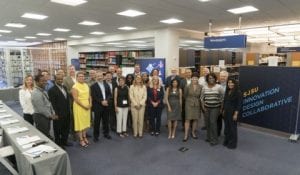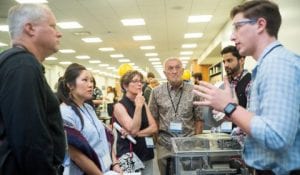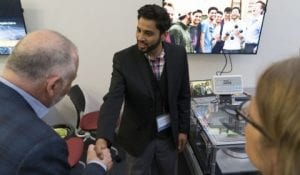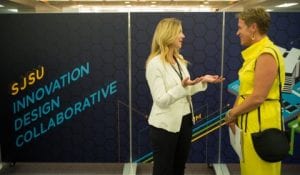- Industry leaders and community partners gathered for the soft launch of the Innovation Design Collaborative at San Jose State on Friday, June 8, 2018.(Brandon Chew/San Jose State University)
- Facebook’s Mark Roenigk (left) listens to SJSU student engineers discuss their magnetic levitation system at the soft launch of the Innovation Design Collaborative at San Jose State University on Friday, June 8, 2018. (James Tensuan/San Jose State University)
- SJSU students share their work on a digital jukebox with industry leaders and community partners at the soft launch of the Innovation Design Collaborative at San Jose State University on Friday, June 8, 2018. (Brandon Chew/San Jose State University)
- Downtown College Prep Co-Founder and Executive Director Jennifer Andaluz (right) with SJSU Senior Director of Development Sabra Diridon at the soft launch of the Innovation Design Collaborative at San Jose State on Friday, June 8, 2018. (James Tensuan/San Jose State University)
By Melissa Anderson
On June 8, in the basement of the Dr. Martin Luther King Jr. Library, students, educators and industry leaders mingled together at the soft launch of San Jose State University’s new Innovation Design Collaborative.
The lower level of the library, which houses the first public materials library as well as shelves of periodicals, is now home to a new interdisciplinary innovation space for students and faculty to work together, and test out ideas.
“A few weeks ago, you would have seen a very different space,” said Paul Lanning, vice president for University Advancement. “This is just the start and we are excited to unveil it for all of you. This is a glimpse of what is to come, not just for San Jose State University, but all the representatives here. This is an interdisciplinary space to work together on every type of unit imaginable.”
The IDC started several years ago when representatives from the Charles W. Davidson College of Engineering connected with a handful of industry partners to discuss ways the university could better prepare students to meet evolving workforce needs. The group grew to include more than 30 industry and educational partners from off campus as well as campus representatives from each college. Now in addition to the advisory group, the university also has a dedicated space for students and faculty to work together to incubate ideas and gain just the type of experience needed to succeed in Silicon Valley after graduation.
During the event, teams of students and recent graduates showcased prototypes of products that are close to launching or ready for national competition. The teams included representatives from different degree programs and colleges who have grappled with technical development, legal questions and marketing.
One team was on the verge of launching a beta version of a digital jukebox that will allow multiple users to develop playlists at gatherings that include songs that appeal to the group – unlike existing music applications that are controlled by individuals.
Another team created an application called Gratis Food that will connect food vendors with excess products to students with food insecurities. The team, which won best overall innovation at SJSU’s Silicon Valley Innovation Challenge and were selected to participate in ZinnStarter through SJSU’s IDEAS program, moved from a nonprofit to a profit model that will be more easily scalable.
“We’ve created a beta version and we plan to expand to community colleges and universities,” said Raghav Gupta, founder and project manager of Gratis Food.
The final team demonstrated Spartan Hyperloop, a magnetic levitation system that they have entered into the SpaceX 2018 Hyperloop Pod Competition, on July 22.
After the networking hour and lunch, President Mary Papazian welcomed the more than 30 industry and educational partners who attended the event, including Joe Pinto, senior VP Technical Services at Cisco Systems, Donna Bell, director of Ford Innovation Research and Innovation Labs, Mark Roenigk, head of hardware at Facebook, Jennifer Andaluz, the co-founder and executive director of Downtown College Prep, and Andrea Schwarz, founding Bay Area executive director of Braven.
“One of the wonderful things about today is that our various programs across the campus are represented and that is where a lot of the magic happens,” Papazian said. “San Jose State University is a place to innovate as evidenced by the Paseo Public Prototyping Challenge and Festival and the Silicon Valley Innovation Challenge, our excellent interdisciplinary academic programs, and the high rate at which our graduates are hired in the Bay Area.”
Pinto, of Cisco, said the IDC is an opportunity for SJSU to play a different role than just supplying talent.
“Silicon Valley is unique with intellectual property, venture funding and a group of universities in an area that people from around the world want to come to innovate and design,” he said. “We are strengthening the ecosystem.”
Dean Sheryl Ehrman, of the Charles W. Davidson College of Engineering, spoke about how important collaboration across disciplines is in grounding innovation with the critical thinking that comes from “cross pollination” with others in the humanities, applied health sciences, business or other perspectives.
While SJSU has a vision for an innovation wing that will become part of a science and innovation complex on campus, the library space is helping to increase capacity for interdisciplinary learning immediately.
“Why are we in the library?” asked University Library Dean Tracy Elliott. “This is where multidisciplinary work happens—the university, the community, all of you use the space. We have all disciplines represented throughout the building.”



